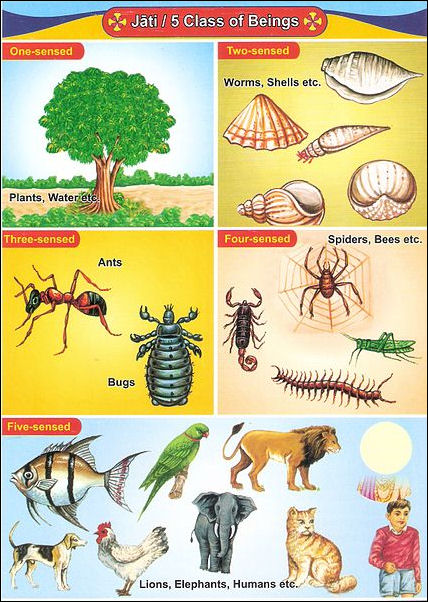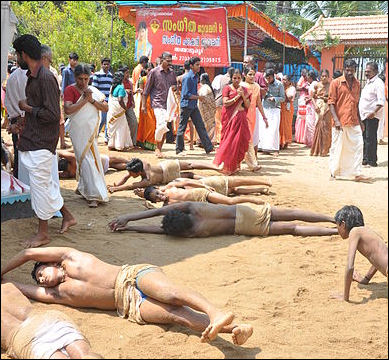HINDU LOVE OF LIFE

Rama with a squirrel
Hindus believe that all living creatures — from bacteria to blue whales, and even some plants — have souls, which are essentially equal, and all these life forms are manifestations of the unity of the universe. This is why Hindus are vegetarians and abhor killing animals; and “ahimsa” — the belief that it is a sin to harm any living creature —is an important precept in Hinduism. The concept was eluded to in the Upanishads and contrasts sharply with doctrines of Western religions which holds that mankind is a special creation on a plane higher than other creatures.
Hindu ethics generally center on ahimsa, which includes the belief in non-violence towards all living beings, especially the cow, which is held sacred. This principle is expressed in almost universally observed rules against eating beef. While not all Hindus are vegetarians, abstinence from all kinds of meat is regarded as a higher virtue. It is worth noting that high-caste Bangladeshi Hindus, unlike their counterparts elsewhere in South Asia, ordinarily eat fish. [Source: Wikipedia]
Classical Hinduism includes ahimsa as a central tenet. The concept was also of great importance to the Buddha and to such reformers as Mahatma Gandhi some 2,500 years later. Veneration of pure life, especially of the cow, has come to be intimately associated with orthodox Hinduism of all sects. The cow is regarded as, among other things, the sacred embodiment of motherhood and fruitfulness. The deliberate killing of a cow is scarcely less terrible than the killing of a Brahman. For the miscreant it results in immediate and irrevocable outcasting; even the accidental killing of a cow requires elaborate purification ceremonies. [Source: Russell R. Ross and Andrea Matles Savada, Library of Congress, 1988]
Websites and Resources on Hinduism: Hinduism Today hinduismtoday.com ; India Divine indiadivine.org ; Wikipedia article Wikipedia ; Oxford center of Hindu Studies ochs.org.uk ; Hindu Website hinduwebsite.com/hinduindex ; Hindu Gallery hindugallery.com ; Encyclopædia Britannica Online article britannica.com ; International Encyclopedia of Philosophy iep.utm.edu/hindu ; The Hindu Religion, Swami Vivekananda (1894), .wikisource.org ; Journal of Hindu Studies, Oxford University Press academic.oup.com/jhs
RECOMMENDED BOOKS:
"An Introduction to Hinduism" by Gavin Flood Amazon.com ;
“Hinduism for Beginners - The Ultimate Guide to Hindu Gods, Hindu Beliefs, Hindu Rituals and Hindu Religion” by Cassie Coleman Amazon.com ;
“Hindu Myths: A Sourcebook” translated from the Sanskrit by Wendy Doniger (Penguin Classics, 2004) Amazon.com ;
“India: A History" by John Keay Amazon.com ;
“The Rig Veda” by Anonymous and Wendy Doniger (Penguin Classics) Amazon.com ;
"The Hindus: An Alternative History" by Wendy Doniger; Amazon.com ;
“The Upanishads” by Anonymous and Juan Mascaro (Penguin Classics) Amazon.com ;
“The Bhagavad Gita” by Anonymous and Laurie L. Patton (Penguin Classics)
Amazon.com ;
“Myths and Symbols in Indian Art and Civilization” by Heinrich Zimmer (Princeton University Press, 1992) Amazon.com
Hindu Beliefs About Existence, Cycles, Life and Death
Hindus believe that the absolute (the totality of existence, including God, man, and universe) is too vast to be contained within a single set of beliefs. Life and death are seen as meaningless cycles. Life itself is often characterized as a dream that has little to with relevance of the true nature of things in terms of the universe, cosmology and forces behind life. Reality is like an onion whose successive layers have to be pealed to reveal the universe eternal truth.

Gandhi cremation On this subject Krishna told Arjuna in the Bhagavad Gita:
“Do not say
“God gave us this delusion.”
You dream you are a doer.
You dream that action is done.
You dream that action bears fruit.
It is your ignorance.
It is your delusion
That gives these dreams.”
The cycles of birth and death are perceived a continuations of the disintegrating force of Creation while transmigration of the soul from one life to another is viewed a perpetuation of the separation of the individual from the unifying force of existence. The aim of the individual is to "get off the wheel," to escape the cycle and merge finally with the Oneness that was there before Creation began. into the original One. Methods used on the path of escaping reincarnation include yoga, meditation, and charity. Since the chances of escaping it are quite low people are encouraged to work to achieve a better position in their next life by doing good deeds, living simply and praying a lot.
Sadhana refers to the a means for the realization of spiritual goals. The word is derived from the root "sadh-", meaning "to accomplish". Different denominations of Hinduism have their own ideas about sadhana but they all aim to achieve liberation from bondage. They have different beliefs about what causes bondage, how to become free from it, and who or what can guide one on that path.
Samsara, Reincarnation and Transmigration
In Hinduism samsara (Sanskrit for migration) refers to the cycle of birth, life, death, and rebirth — reincarnation. It is not mentioned in the early Hindu texts such as the Rigveda. The later parts of Rigveda do mention ideas that suggest an approach towards the idea of rebirth. The idea of reincarnation and karma have roots in the Upanishads of the late Vedic period, predating the Buddha. [Source: Wikipedia]
Reincarnation is the transmigration of the soul from one life form to another. It doesn’t just apply to humans but to all creatures and some non-living things too. Transmigration of the soul can take place from a human or creature into another human or creature up or down a scale based on good and evil deeds (See Karma Below). If a person has lived a virtuous life he moves up the scale, say, from a low caste to a high caste. If a person has lived an unworthy life he moves down the scale, say, from a low caste to a rat.
Reincarnation is a belief found in most Asian religions and is a cornerstone of all the major religions found in India except Islam. The Hindu idea of reincarnation is roughly the same regardless of which Hindu god an individual venerates most.
The Hindu concept of samsara first appeared in the Upanishads and is believed to have originated in the Ganges Plain and was absorbed b the Aryan-centered Hinduism as the Aryans moved into the Ganges Plain. Beliefs in reincarnation are not just found in India and Asia but are found in tribal cultures all over the world and were held by the ancient Greeks, Vikings and other groups in the West. Ideas about reincarnation are probably very old and were held by people who lived in Neolithic times.
Hindu Beliefs About Reincarnation

Hierarchy of Beings according to Jain Thought
but also applicable to Hindu, Buddhist Thought
Reincarnation is viewed as a never-ending set of cycles ( “yugas” and “ kalpas” ). One may be reincarnated millions of times. Samsara” more specifically refers to the doctrine that the soul repeatedly dies and is reborn. “Karma” determines what a person is reincarnated as. Escape from the weary cycle of reincarnation can be achieved through escape into “an unchanging anonymous Absolute" and attaining “moksha” , the Hindu equivalent or “nirvana” .
According to the Pew Research Center: Four-in-ten Indian Hindus believe in reincarnation. Although reincarnation is a mainstream teaching in Hinduism, fewer than half of Hindus express belief in this teaching. College-educated Hindus are slightly less likely than others to say they believe in reincarnation (34 percent vs. 41 percent). [Source: Jonathan Evans, Pew Research Center, October 26, 2022]
According to the BBC: “Hindus believe that the soul passes through a cycle of successive lives (samsara) and its next incarnation is always dependent on how the previous life was lived (karma). In a lifetime people build up karma, both good and bad, based on their actions within that lifetime. This karma affects their future lives and existences. People must take responsibility for their actions either within this life time or the next. Death is a key part of this cycle and is treated with specific importance. Death is the last samsara (cycle of life) referred to as the 'last sacrifice'.” [Source: BBC]
According to Hindu theology an “atman” (an internal self or soul) dwells in each person as a kind of cosmic energy that exists beyond worldly reality and karma and doesn’t require good deeds or prayers to improve on itself. The problem is that few creatures can tune into their atman and thus require deeds and prayer to help them establish their place in the world Reincarnation helps them do this and evolve to reach closer to their atman.
ehavior at the end of one’s life and last thought before dying are believed to be very important in determining how an individual will be reincarnated. Thus a great deal of care goes into making sure a person is well cared before they die and after. This is achieved by creating a calm atmosphere and reading Vedic scriptures and reciting mantras so the soon-to-be-dead can earn as much merit as possible.
Karma
Karma (universal justice) is the belief that the consequence of every good or bad action must be fully realized. Karma is the means in which a person controls his or her destiny through good or evil deeds. Defined by some scholars as “the whole ethical consequences of one’s actions,” it is a moral force that survives death, determines one’s existence in future lives and has defined existence in past lives.

karma
Karma is a Sanskrit word that means "work" or "action” and the “result of a work or action.” It describes a "reap what you sow" and the “cause and effect” doctrine in which good actions will be rewarded and bad actions will be punished on both universal and individual levels and influence one’s reincarnation. The emphasis in karma beliefs is not based on punishment for bad deeds but rather on improving one's karma by learning from one's mistakes and performing pure deeds, praying, mediating and taking actions to purify oneself.
As this relates to samsara ( the transmigration of souls), rebirth is required by karma in order that the consequences of action be fulfilled. The role an individual must play throughout his or her life is fixed by his or her good and evil actions in previous existences. It is only when the individual soul sees beyond the veil of maya (illusion or earthly desires) — the forces leading to belief in the appearances of things — that it is able to realize its identity with the impersonal, transcendental reality (world soul) and to escape from the otherwise endless cycle of rebirth to be absorbed into the world soul. This release is known as moksha. [Source: Andrea Matles Savada, Library of Congress, 1991 *]
Karma fits into the Vedic theory of the 'moral law of cause and effect.' The theory combines causality, which may be ethical or non-ethical, with ethicization, with good or bad actions having consequences on birth. The Karma theory explains an individual's present circumstances with reference to their past actions, which may have occurred in their current life or, according to some schools of Hinduism, in past lives. Samsara According to Hindu beliefs, liberation from samsara through moksha guarantees lasting happiness and peace. Hindu scriptures teach that the future is determined by both current human effort, which is derived from free will, and past human actions that set the circumstances. [Source: Wikipedia]
According to Hindu theology an “atman” (an internal self or soul) dwells in each person as a kind of cosmic energy that exists beyond worldly reality and karma and doesn’t require good deeds or prayers to improve on itself. The problem is that few creatures can tune into their atman and thus require deeds and prayer to help them establish their place in the world Reincarnation helps them do this and evolve to reach closer to their atman.
See Separate Article: KARMA factsanddetails.com
Karma, Reincarnation and Caste
The concepts of reincarnation, caste and karma are linked, with karma being carried over from one life to the next, determining the life or caste of a person in their next life. Based on whether their karma is generally good or bad, people are reborn in higher or lower castes. Some sinners come back as animals that befits their crimes. A meat stealer may come back as a jackal, a grain thief as a rat. The worst sinners are condemned to the lowest hells where they are eaten by birds or cooked in pots.
Indian religious tradition sees karma as the source of the problem of transmigration. While associated with physical form, for example, in a human body, beings experience the universe through their senses and their minds and attach themselves to the people and things around them and constantly lose sight of their true existence as atman , which is of the same nature as brahman . As the time comes for the dropping of the body, the fruits of good and evil actions in the past remain with atman , clinging to it, causing a tendency to continue experience in other existences after death. Good deeds in this life may lead to a happy rebirth in a better life, and evil deeds may lead to a lower existence, but eventually the consequences of past deeds will be worked out, and the individual will seek more experiences in a physical world. In this manner, the bound or ignorant atman wanders from life to life, in heavens and hells and in many different bodies. The universe may expand and be destroyed numerous times, but the bound atman will not achieve release. [Source: Library of Congress]
Karma, Character and Behavior
Hinduism teaches one to accept the injustices of life and be patient for rewards that may not materialize until their next life. High positions are not earned and low positions must be accepted. Some scholars have argued that beliefs in transmigration and karma originated as a way to explain social and economic discrepancies, to create an incentive to act morally and to offer people who were dealt a bad set of cards some hope in the future, in their next life.
It has also been argued that beliefs of karma and reincarnation encourage passivity with Hindus accepting their often miserable fate and taking little initiative to improve their lives or get rid of the poverty and misery around them. The beliefs also produce a resigned “inshallah” approach to life — with victims of bad events chalking up the events to bad karma, and in some cases even feeling relieved because they feel their bad karma has been used up and better things will happen in the future.
Parkish Louis, of the Indian Social Institute, a Delhi think tank, told the Financial Times, "People have been for centuries oppressed, passive, paralyzed and marginalized by beliefs of karma and destiny. People are accepting their misery in the name of religion and beliefs.” This attitude is also said to encourage irresponsibility and make people more accepting of corruption than they otherwise would be.
Hindu Merit and Penitence

rolling babas The idea of merit get more attention in Buddhism than Hinduism but is still important in Hinduism. It is linked with karma. Merit is sort of like brownie points that helps one ascend to higher reincarnation levels and eventually reach the state of enlightenment. Earning merit is essentially the same thing as earning good karma and has been described as a “spiritual bank account” in which “doing bad things are withdrawals; making merit is a deposit.”
Extreme forms of penitence are central parts of Thaipusam, a festival celebrated at Batu Caves outside Kuala Lumpur, Malaysia. Devotees carry “kavadis” (large, colorful steel frames) supported on spikes, spears and hooks that pierce their flesh and skin. The devotees wear the kavadis to fulfill thanksgiving vows for having had their prayers answered the previous year. The participants fast and abstain from sex and alcohol for a month before the ritual so they are pure. Apples, fruit and coconuts and other objects carried on the kavadis are presented at Lord Subramaniam's shrine. Devotees also saw and place spikes through their tongue and make quarter-size holes in their cheeks with lances and stick a poles though them. Cheek piercing with sharpened metal rods is part of prayer ceremonies held in the Punjabi city of Ludhiana.
Some women have the word Rama written over and over again across their saris and cloaks. Women of the Namdhari sect even tattoo Sanskrit lines of the word across their face.
Penitence, See Sadhus, Holy Men
Image Sources: Wikimedia Commons
Text Sources: “World Religions” edited by Geoffrey Parrinder (Facts on File Publications, New York); “Encyclopedia of the World’s Religions” edited by R.C. Zaehner (Barnes & Noble Books, 1959); “Encyclopedia of the World Cultures: Volume 3 South Asia “ edited by David Levinson (G.K. Hall & Company, New York, 1994); Wikipedia, BBC, National Geographic, the New York Times, Washington Post, Los Angeles Times, Smithsonian magazine, The New Yorker, Reuters, AP, AFP, Lonely Planet Guides, Compton’s Encyclopedia and various books and other publications.
Last updated March 2024
